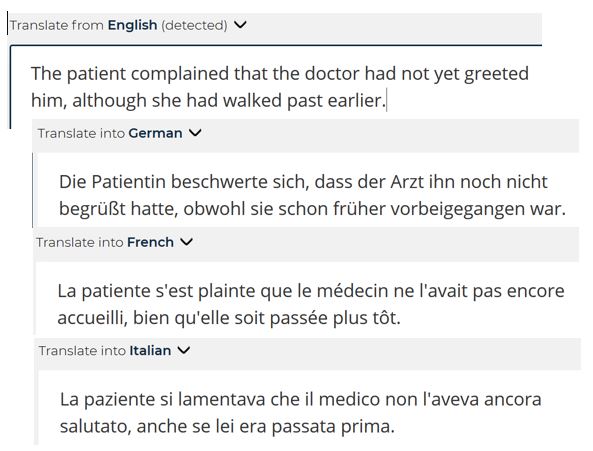“Why do you bother teaching students how to translate? Just tell them to use Google and DeepL!” This is what I often hear from people who have recently discovered these online tools.
By Maureen Ehrensberger-Dow, Professor of Translation Studies at the IUED Institute of Translation and Interpreting
Easy access to apparently free translation has convinced many users that the problem of producing texts in several languages has been solved. However, NMT systems treat each clause and sentence in isolation and do not actually translate texts at all. Crucial features such as correct pronoun reference, consistent terminology, logical information structure, and culture-appropriate references have to be ensured by so-called post-editors. For example, the English sentence “The patient complained that the doctor had not yet greeted him, although she had walked past earlier.” becomes confusing in German (Die Patientin beschwert sich, dass der Arzt ihn noch nicht begrüßt hat, obwohl sie schon früher vorbeigegangen war.) because DeepL cannot understand that the patient is a man and the doctor is a woman. How could it? It is just a machine! Language developed to allow us to communicate and deal with new situations, and people will continue to be part of the most interesting aspects of text production in the future.

These topics are the focus of post-editing workshops that the IUED Institute of Translation and Interpreting offers, in conjunction with the University of Zurich or onsite for industry partners through our continuing education unit. Human intuition, special skills, high levels of concentration and practice are required to do post-editing well, which is why this is also an important component of the IUED MA Specialisation in Professional Translation.

Very true. The performance of NMT nowadays is impressive, indeed. Yet, It’s the post-editing step that is of utmost importance in order to deliver proper results. NMT is not context-aware beyond a sequence, and even within, as the article points out, it can get confused easily. Due to this, it lacks consistency in the terminology used. It might also be biased due to the text material used to actually teach the NMT model. Make no mistake! auto-translation is a great tool, but post-processing is paramount to deliver outstanding results.